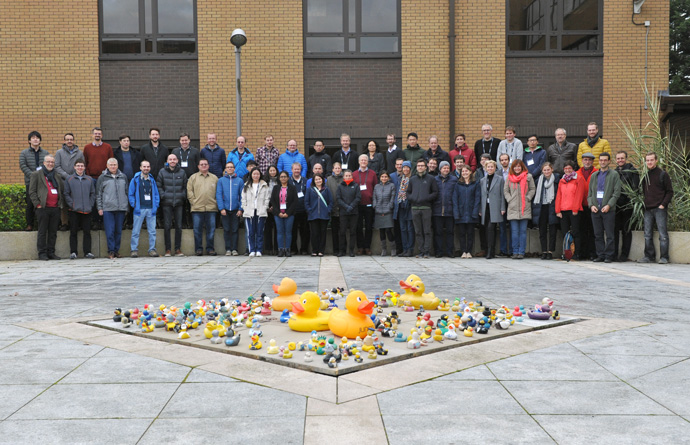ECMWF | Reading | 18-21 November 2019
Workshop description
This workshop brought together experts to discuss and propose ways forward in representing the stratosphere in current and future numerical weather prediction models (1-50 km resolution, forecast lead times from medium-range to seasonal), and pathways by which better treatment of the stratosphere can improve predictive skill in the troposphere. The topics included understanding and diagnosing stratosphere-troposphere interactions, improved parametrizations and numerical schemes, the role of water vapour and ozone, observational evaluation and data assimilation. The aim of the workshop was to provide guidance to ECMWF on the priorities for representing the stratosphere in the coming decade.
Presentations and recordings
Monday 18 November 2019
|
Welcome and opening |
||
|
Importance of the stratosphere for extended-range prediction |
||
|
The representation of stratosphere-troposphere coupling in S2S models |
||
|
A signal and noise analysis of stratosphere-troposphere coupling in sub-seasonal prediction models |
||
|
The importance of stratospheric initial conditions for winter North Atlantic Oscillation predictability |
||
|
Subseasonal-to-seasonal predictability of the Southern Hemisphere eddy-driven jet during austral spring and early summer |
||
|
On the dynamics of stratosphere-troposphere planetary-wave coupling |
||
|
Subseasonal Forecasting of Sudden Stratospheric Warming Events and their Influence on the Troposphere in the NASA-GEOS-S2S Forecast System |
Tuesday 19 November 2019
Wednesday 20 November 2019
|
Recent work at DWD to improve model dynamics and physics in the stratosphere and mesosphere |
||
|
A new approach to linear ozone modelling |
||
|
Dependence of simulated atmospheric teleconnections on biases in stratospheric circulation |
||
|
Dynamics of Sudden Stratospheric Warmings |
||
|
Stratospheric data assimilation at ECMWF |
||
|
How does the Troposphere Amplify Stratospheric Variability? |
||
|
Using causal discovery algorithms to evaluate troposphere-stratosphere linkages in reanalyses and modelling experiments |
||
|
Remote presentation: Propagating annular modes |
n/a |
|
|
Investigation of ECMWF IFS Arctic winter 2015/16 lowermost stratosphere moist bias using airborne limb-imaging infrared observations |
Thursday 21 November 2019
|
Global gravity wave distributions observed from satellites and resolved in the ECMWF-IFS |
||
|
Stratospheric waves over the Southern Andes |
||
|
Beyond Traditional Limits of Gravity-Wave Parameterizations: Transient Wave-Mean-Flow Interactions and Unbalanced Mean Flows |
||
|
How does knowledge of atmospheric gravity waves guide their parametrizations? |
||
|
Stratospheric impacts of a source-based parameterization of gravity waves generated by flow imbalance |
Posters
|
The zonally-asymmetric response to stratospheric forcing in the Atlantic and Pacific storm tracks |
|
|
Eliassen Palm Fluxes and Stratospheric circulations - Teleconnections as forcing |
|
|
Towards a transient gravity wave drag parameterization |
|
|
Seasonal Forecasting of the Quasi-Biennial Oscillation |
|
|
The Combined Influence of the MJO and the Stratospheric Polar Vortex on Subseasonal Northern Hemisphere Winter Weather Patterns |
|
|
Zonally asymmetric tropospheric signatures of polar vortex splits and displacements |
|
|
ENSO influence on the North Atlantic: Quantifying nonlinearity and relative role of the stratospheric and the tropospheric pathways |
|
|
Coupling convective sources to a transient gravity-wave parametrization in ICON |
|
|
Homogeneity of the temperature data from renalyses |
|
|
Abrupt stratospheric vortex weakening associated with North Atlantic anticyclonic wave breaking |
|
|
Evaluation of revised gravity wave parametrizations using statistics of first-guess departures |
|
|
Storyline Description of Southern Hemisphere Midlatitude Regional Climate Change |
|
|
Impact of satellite observations on forecasting sudden stratospheric warmings |
|
|
Real-time predictions of the 2019 New Year Stratospheric Sudden Warming in Multiple S2S Models |
|
|
Downward Influence of the 2018 and 2019 SSW events in S2S Models |
|
|
Can Solar cyclic variability modulate winter Arctic climate? |
|
|
On the development of NCEP 127-L GFS with its top extending to the mesopause |
|
|
Do sudden stratospheric warmings boost convective activity in the tropics? |
Working group questions
Processes
- Which stratospheric processes are important to represent accurately for improved tropospheric predictability on medium-range to seasonal timescales?
- Which tropospheric processes are important to represent accurately for improved stratospheric predictability?
- Can we quantify the strength of stratospheric impact on the troposphere (e.g., following weak and/or strong vortex events) versus the impact of other remote forcers such as MJO and ENSO?
- What are the best tools and metrics to objectively evaluate the strength of the stratosphere-troposphere coupling, and, the skill provided by the stratosphere for tropospheric predictability?
Model design and development
- What can be done to eradicate persistent stratospheric biases shared by many models? Is there an indication that certain biases are more important than others for tropospheric predictability?
- What is the most efficient testing protocol for assessing if model changes result in an enhanced tropospheric skill as a result of a better stratospheric representation? For example, should we be focusing on the time periods around “windows of opportunity” (e.g., SSWs, final warmings in the Southern Hemisphere) when stratosphere is known to impact the troposphere?
- How important is adding more complexity to parametrization design is for stratospheric circulation? E.g., should we be building source dependency into nonorographic gravity wave drag parametrizations in high resolution models? Should we be incorporating 3D propagation into gravity wave drag schemes?
- Are there certain dynamical core designs that are known to better represent stratospheric processes (e.g., gravity waves, transport, QBO) and/or stratosphere-troposphere coupling?
- Does the location of model top matter for stratospheric and/or tropospheric predictability? If so, where should the model top be located?
Role of observations
- Are there any additional observations which are needed to enable model improvements relevant for weather prediction?
- Are observational data sufficient to initialize the stratosphere?
- How much do (or should) modellers trust stratospheric re-analyses?
Organising committee
Inna Polichtchouk, Peter Bechtold, Michail Diamantakis, Robin Hogan, Irina Sandu, Tim Stockdale, Nils Wedi

